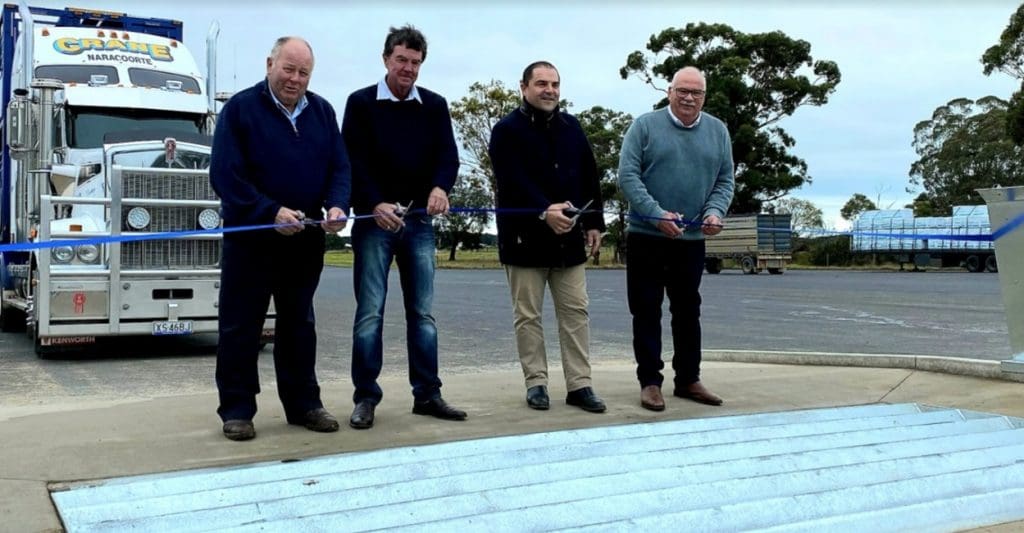
At the opening were, from left, John Beer, LRTAV; Cr Barry Kuhl; Tony Pasin, Federal Member for Barker and Grant council mayor Richard Sage.
A NEW livestock effluent disposal pit has been opened at the Mount Gambier and District Saleyards for all stock transporters.
An official opening by Assistant Minister for Road Safety and Freight Transport Scott Buchholz was hosted by the District Council of Grant yesterday.
Mr Buchholz said the practical and sustainable disposal facility will benefit the entire livestock production chain including producers, transporters, processors and of course other road users throughout the community.
He said the new effluent disposal site demonstrated that there is the opportunity for further sites to be developed around the country.
“Hopefully this new site at Mount Gambier will be a prototype for future rollouts of similar effluent disposal facilities, to help complete a map of facilities across the national road network, supporting our livestock and transport sectors.”
Federal Member for Barker Tony Pasin MP said the Mount Gambier disposal pit was funded by the Australian Government through the National Heavy Vehicle Regulator’s (NHVR) Heavy Vehicle Safety Initiative.
“The facility is positioned to help countless heavy vehicle drivers transporting livestock to access the disposal site situated along a major cattle route on the Australian road network.”
“The livestock transporters, the quiet heroes of the Australian Livestock industry, will be able to enter the site, discharge tanks and resume transport in a safe, efficient and productive manner.”
Mt Gambier saleyards manager David Wallis said the project was a joint initiative of the Australian Livestock and Rural Transporters Association (ALRTA) and the District Council of Grant (Council).
“Together, we agreed to deliver this project to effectively provide an opportunity for livestock transporters to dispose of effluent in eastern South Australia and we thank ALRTA for the opportunity.
“The newly installed pit means transporters can dispose of accumulated livestock effluent either at the end of their journey to the saleyards, or on their way to deliver a consignment further afield,” Mr Wallis said.
ALRTA president Scott McDonald, said that managing effluent in transit is a significant challenge for their members.
“Effluent capture tanks installed on purpose-built livestock trailers do a reasonable job of containment however there is a need for transporters to access suitable facilities for disposal when tanks become full in transit and at ‘end of journey’ facilities.
“Disposal facilities benefit the livestock supply chain and the community,” he said.
“They improve safety by ensuring cleaner roads and improved animal welfare outcomes and help to reduce the risk of non-compliance with biosecurity, environment and load restraint laws.
“That’s why the ALRTA is actively engaging with industry stakeholders and governments to develop a national network of effluent disposal points.”
Local ALRTA member, Peter Edmonds said Mount Gambier saleyards was an ideal location for installation of a livestock effluent disposal facility.
“It’s just off the Princes Highway, not a big detour into the site, and it draws in livestock trucks driving through Mount Gambier from the north as well as trucks from the west heading to Midfield Meats and beyond,” he said.
Mr Edmonds recently trialled a B-double over the grids and commented that the facility is ideally set up to empty tanks from both crates into the two large grids.
“There are four floodlights installed, one on each corner of the facility, so the effluent pit can be used after dark.
“The short hoses have good pressure and are ideal for washing down tyres, mud flaps and plugs, but won’t stretch to clean out crates, so the effluent pits should be relatively quick to use and won’t become just another truck wash queue,” he said.
NHVR chief executive officer Sal Petroccitto said the Heavy Vehicle Safety Initiative had so far allocated $22.8m through 89 separate grants over the past five years.
“Heavy vehicle safety and safety for all drivers is the top priority of the NHVR,” Mr Petroccitto said.
“These grants enable the NHVR, industry and other stakeholders to deliver innovative solutions for heavy vehicle safety and those that operate them.”

HAVE YOUR SAY